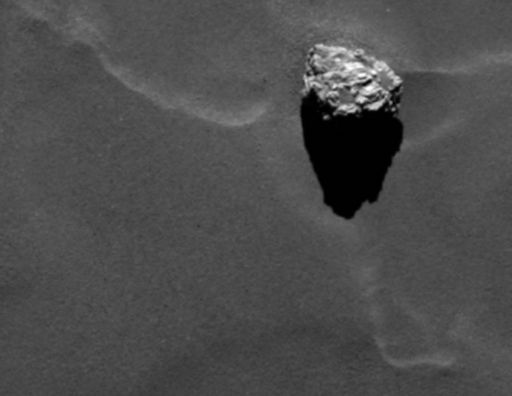Daily Suspicious0bserver's Weather Post:
October 14, 2014
What's in the sky tonight?
October 14, 2014
-When the European Space Agency's Rosetta probe arrived at Comet 67P/Churyumov–Gerasimenko in August, one of the biggest surprises was the boulders: The comet's core is littered with them. Rosetta's OSIRIS camera photographed this specimen, a 45-meter-wide behemoth named "Cheops," on Sept. 19th. On Nov. 12th, Rosetta will drop a lander onto the surface of the comet, and these boulders are a key hazard Philae must avoid.
But are they really boulders? "Maybe they only look like rocky boulders," says Art Chmielewski, the US Rosetta Project Manager at JPL. "Some scientists believe that they are 'flimsy' boulders. They may be more like dirty snow balls made in very cold weather. If so they are very fragile and would collapse under the lander. I hope Philae will not find out if that is true."
Claudia Alexander, the Project Scientist for the US Rosetta Project says the boulders could be telling us something new about the way comets "sublimate"--that is, the way sunlight converts cometary ices into jets of gas. "I personally wonder if we've gotten the sublimation process understood in the reverse. In other other words, instead of sublimation coming forth from a crack or fissure in the ground, sublimation emerges from cliff-sides, or 'spires' or vertical features, and then these features collapse when the vapor has been evacuated." Boulders could be debris from such a process.
"Obviously Rosetta is perfectly poised to make the measurements that will help us understand the physics of this process, and better understand cometary geology!"
 Astro Picture of the Day:
October 14, 2014
Source:
Astro Picture of the Day:
October 14, 2014
Source:
Higher than the highest mountain lies the realm of the aurora. Auroras rarely reach below 60 kilometers, and can range up to 1000 kilometers. Aurora light results from energetic electrons and protons striking atoms and molecules in the Earth's atmosphere. Somewhat uncommon, an auroral corona appears as a center point for a surrounding display and may occur when an aurora develops directly overhead, or when auroral rays are pointed nearly toward the observer. This picturesque but brief green and purple aurora exhibition occurred last month high above Kvaløya, Tromsø, Norway. The Sessøyfjorden fjord runs through the foreground, while numerous stars are visible far in the distance.